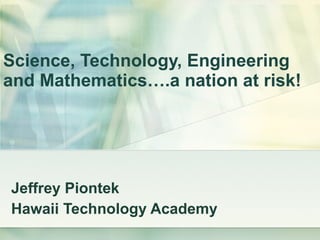
Combating Stem
- 1. Science, Technology, Engineering and Mathematics….a nation at risk! Jeffrey Piontek Hawaii Technology Academy
- 7. The Primary aim of education is not to enable students to do well in school, but to help them do well in the life they will lead outside of school.
- 8. So where is this all leading…. STEM EDUCATION
- 9. U.S. students must compete in a new global economy. Hershey is opening their next plant in…… MEXICO!!!
- 31. Preparing for and Completing College in the U.S.A.
- 32. Out of every 100 ninth graders….
- 33. 68 will graduate from high school
- 34. 40 will enter college
- 35. 26 are still enrolled in the sophomore year
- 36. 18 will graduate from college
- 39. Job Outlook 2002, National Association of Colleges and Employers (NACE)
- 40. M athematics E ngineering T echnology S cience
- 41. So what does this mean to Science Teachers and Science Professionals?
- 42. "Science is built of facts as a house is built of bricks; but an accumulation of facts is no more science than a pile of bricks is a house." It means we need a scientifically and “informationally” literate society…..remember Sputnik?
- 45. Using information literacy as an inquiry process to increase science literacy
- 53. ENGINEERS make a world of difference by turning ideas into reality. Engineers question and challenge the things we encounter in everyday life. They seek to improve the products we use in all aspects of our lives. A degree in engineering is preparation for many different careers in almost any field. Why Engineering?
- 64. Where are we? Where do we want to be? How do we get there? STEM Education
- 66. Where are we?--- Universities KathySierra http://headrush.typepad.com/creating_passionate_users/
- 71. Managing Complex Change Vision CHANGE Skills + Incentive + Resources + Action Plan +
- 72. Managing Complex Change Vision Skills + Incentive + Resources + Action Plan + Confusion
- 73. Managing Complex Change Vision Skills + Incentive + Resources + Action Plan + Anxiety
- 74. Managing Complex Change Vision Skills + Incentive + Resources + Action Plan + RESISTANCE
- 75. Managing Complex Change Vision Skills + Incentive + Resources + Action Plan + FRUSTRATION
- 76. Managing Complex Change Vision Skills + Incentive + Resources + Action Plan + TREADMILL
- 83. Science Today, with students creating their own learning
- 88. Practice your Mandarin in Yuan Ming Yuan
- 89. Talk and Role Play with Students in Beijing
- 92. Create Worlds Create Worlds
- 96. New Sports
- 97. New Robots
- 98. Research in new ways
- 99. Through Simulation, Conduct Experiments Too Dangerous or Too Expensive in the Real World
- 101. “ Garfield” by Jim Davis The Future of STEM … Use STEM to build communities that solve human problems
- 102. Developing a Shared Agenda finding common ground… INDUSTRY Retention; early student interest; relevance Shorten ramp-up time on large, complex projects Early exposure to complex concepts Early hands-on taught throughout the curriculum ACADEMIA FOR DIFFERENT REASONS FOR DIFFERENT REASONS SIMILAR OBJECTIVES SIMILAR OBJECTIVES FAVORS VALUES IN ORDER TO TO IMPROVE
- 103. We can talk and dream about the glorious schools of the future ---
- 104. OR WE CAN CREATE THEM!
- 105. Each moment we live never was before and will never be again.
- 106. And yet what we teach children in school that 2 + 2 = 4 and Paris is the capital of France. What we should be teaching them is what they are.
- 107. You are a marvel. You are unique. We should be saying: “Do you know what you are?
- 108. You may become a Shakespeare, a Michelangelo, a Beethoven. In all the world there is no other child exactly like you. Photo by Evert Odekerken
- 109. You have the capacity for anything. Yes, you are a marvel.” ~ Pablo Casals
- 110. Let’s start a new conversation about our children, one that puts them at the center and supports them to live in this new and ever changing world. Each and everyone of them deserve more from us…….. So how do we do that???
- 111. STEM
